MERCEDES-BENZ SLC ROADSTER 2018 Service Manual
Manufacturer: MERCEDES-BENZ, Model Year: 2018, Model line: SLC ROADSTER, Model: MERCEDES-BENZ SLC ROADSTER 2018Pages: 298, PDF Size: 5.26 MB
Page 41 of 298

regular intervalswhile the engine is running.
Therefore, malfunctions can be detected in
good time.
The 6 restraint system warning lamp on the
instrument cluster lights up when the ignitio nis
switched on. It goes out no later than afew sec-
onds after the vehicleiss tarted. The compo-
nents of the restraint system are in operational
readiness.
Am alfunction has occurred if the 6restraint
system warning lamp:
Rdoes not light up after the ignitio nisswitched
on
Rdoes not go out after afew seconds with the
engine running
Rlights up again while the engine is running
GWARNING
If the restraint system is malfunctioning,
restraint system components may be trig-
gered unintentionally or may not deploy as
intended during an accident. This can affect
for examplet he Emergency Tensioning
Device or the air bag .This poses an increased
risk of injury or even fatal injury.
Have the restraint system checked and
repaired in aqualified specialist workshop as
soon as possible.
PASSENGER AI RBAG indicator lamp
PASSENGER AIR BAG ON indicator lamp :and
PASSENGER AIR BAG OFF indicator lamp ;are
part of the Occupant Classification System
(OCS). The indicator lamp
sdisplay the status of the
front-passenge rfront air bag.
RPASSENGER AIR BAG ON lights up for 60 sec-
onds, subsequently both indicator lamp sare
off (PASSENGER AIR BAG ON and OFF): the
front-passenge rfront air bag is abl etodeploy
in the event of an accident.
RPASSENGER AIR BAG OFF lights up: the front-
passenger front air bag is deactivated. It will
then not be deploye dinthe event of an acci-
dent.
If the PASSENGER AIR BAG ON indicator lamp is
off, only the PASSENGER AIR BAG OFF indicator lamp shows the status of the front-passenger
front air bag .The PASSENGER AIR BAG OFF
indicator lamp may be lit continuously or be off.
Depending on the person in the front-passenger
seat, the front-passenge rfront air bag must
either be deactivated or enabled; see the fol-
lowing points. You must make sure of this both
before and during ajourney.
RChildren in achildr estraint system:
whethert he front-passenge rfront air bag is
enabled or deactivated depends on the instal- led child restraint system, and the age and
size of the child.T herefore, be sure to observe
the notes on the "Occupant Classification
System (OCS)" (
Ypag e45) and on "Chil-
dren in the vehicle" (Ypag e53). There you
wil lalsof ind instructions on rearward and
forward-facing child restraint systems on the
front-passenge rseat.
RAll other persons: depending on the classi-
ficatio nofthe person in the front-passenger
seat, the front-passenge rfront air bag is ena-
bled or deactivated (
Ypag e45). Be sure to
observe the notes on "Seat
belts“ (
Ypag e39) and "Air bags"
(Ypag e43).T here you can als ofind infor-
mation on the correct seat position.
Seat belts
Introduction
Seat belts are the most effective means of
restricting the movement of vehicleo ccupants
in the event of an accident or the vehicler olling
over. This reduces the risk of vehicleo ccupants
coming into contact with parts of the vehicle
interior or being ejected from the vehicle. Fur-
thermore, the seat belt helpstok eep the vehicle
Occupant safety39
Safety
Z
Page 42 of 298
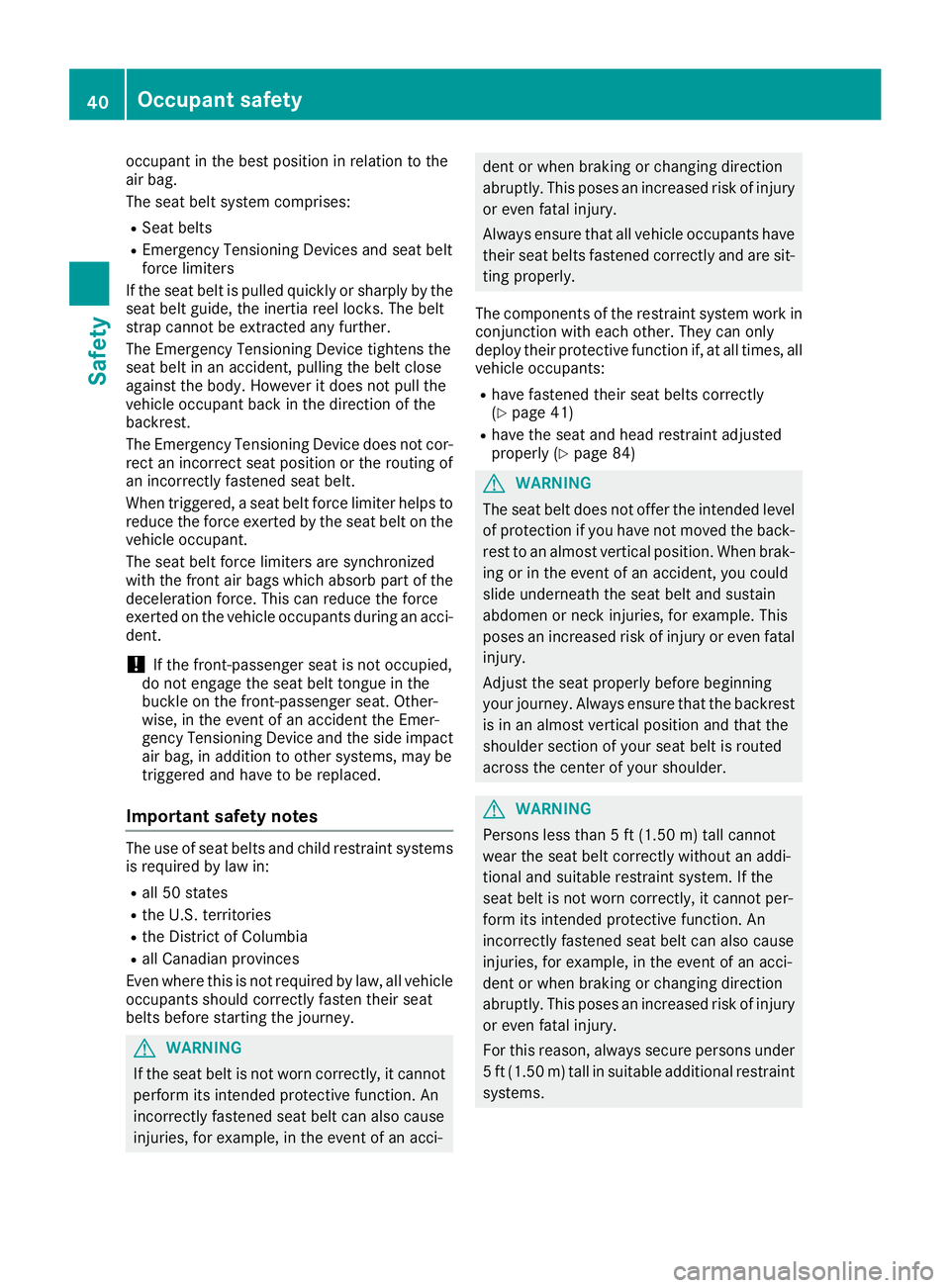
occupant in the best position in relation to the
air bag.
The seat belt system comprises:
RSeat belts
REmergency TensioningDevices and seat belt
force limiters
If the seat belt is pulled quickly or sharply by the
seat belt guide, the inertia reel locks. The belt
strap cannot be extracted any further.
The Emergency TensioningD evice tightensthe
seat belt in an accident,p ulling the belt close
against the body. However it does not pull the
vehicle occupant back in the direction of the
backrest.
The Emergency TensioningD evice does not cor-
rect an incorrect seat position or the routing of
an incorrectly fastened seat belt.
When triggered, aseat belt force limiter helps to
reduce the force exerted by the seat belt on the
vehicle occupant.
The seat belt force limiters are synchronized
with the front air bags which absorb part of the
deceleration force. This can reduce the force
exerted on the vehicle occupantsd uring an acci-
dent.
!If the front-passenger seat is not occupied,
do not engage the seat belt tongue in the
buckle on the front-passenger seat. Other-
wise, in the event of an accident the Emer-
gency TensioningD evice and the side impact
air bag, in addition to other systems, may be
triggered and have to be replaced.
Important safety notes
The use of seat belts and child restraint systems
is required by law in:
Rall 50 states
Rthe U.S. territories
Rthe District of Columbia
Rall Canadian provinces
Even where this is not required by law, all vehicle
occupantss hould correctly fasten their seat
belts before starting the journey.
GWARNING
If the seat belt is not worn correctly, it cannot
perform its intended protective function. An
incorrectly fastened seat belt can also cause
injuries, for example, in the event of an acci-
dent or when braking or changing direction
abruptly. This poses an increased risk of injury or even fatal injury.
Always ensure that all vehicle occupantsh ave
their seat belts fastened correctly and are sit-
ting properly.
The components of the restraint system work in
conjunction with each other. They can only
deploy their protective function if, at all times, all vehicle occupants:
Rhave fastened their seat belts correctly
(Ypage 41)
Rhave the seat and head restraint adjusted
properly (Ypage 84)
GWARNING
The seat belt does not offer the intended level of protection if you have not moved the back-
rest to an almost vertical position. When brak-
ing or in the event of an accident,y ou could
slide underneath the seat belt and sustain
abdomen or neck injuries, for example. This
poses an increased risk of injury or even fatal injury.
Adjust the seat properly before beginning
your journey. Always ensure that the backrest
is in an almost vertical position and that the
shoulder section of your seat belt is routed
across the center of your shoulder.
GWARNING
Persons less than 5ft(1.50 m) tall cannot
wear the seat belt correctly without an addi-
tional and suitable restraint system. If the
seat belt is not worn correctly, it cannot per-
form its intended protective function. An
incorrectly fastened seat belt can also cause
injuries, for example, in the event of an acci-
dent or when braking or changing direction
abruptly. This poses an increased risk of injury or even fatal injury.
For this reason, alwayss ecure persons under
5ft( 1.50 m) tall in suitable additional restraint
systems.
40Occupant safety
Safety
Page 43 of 298
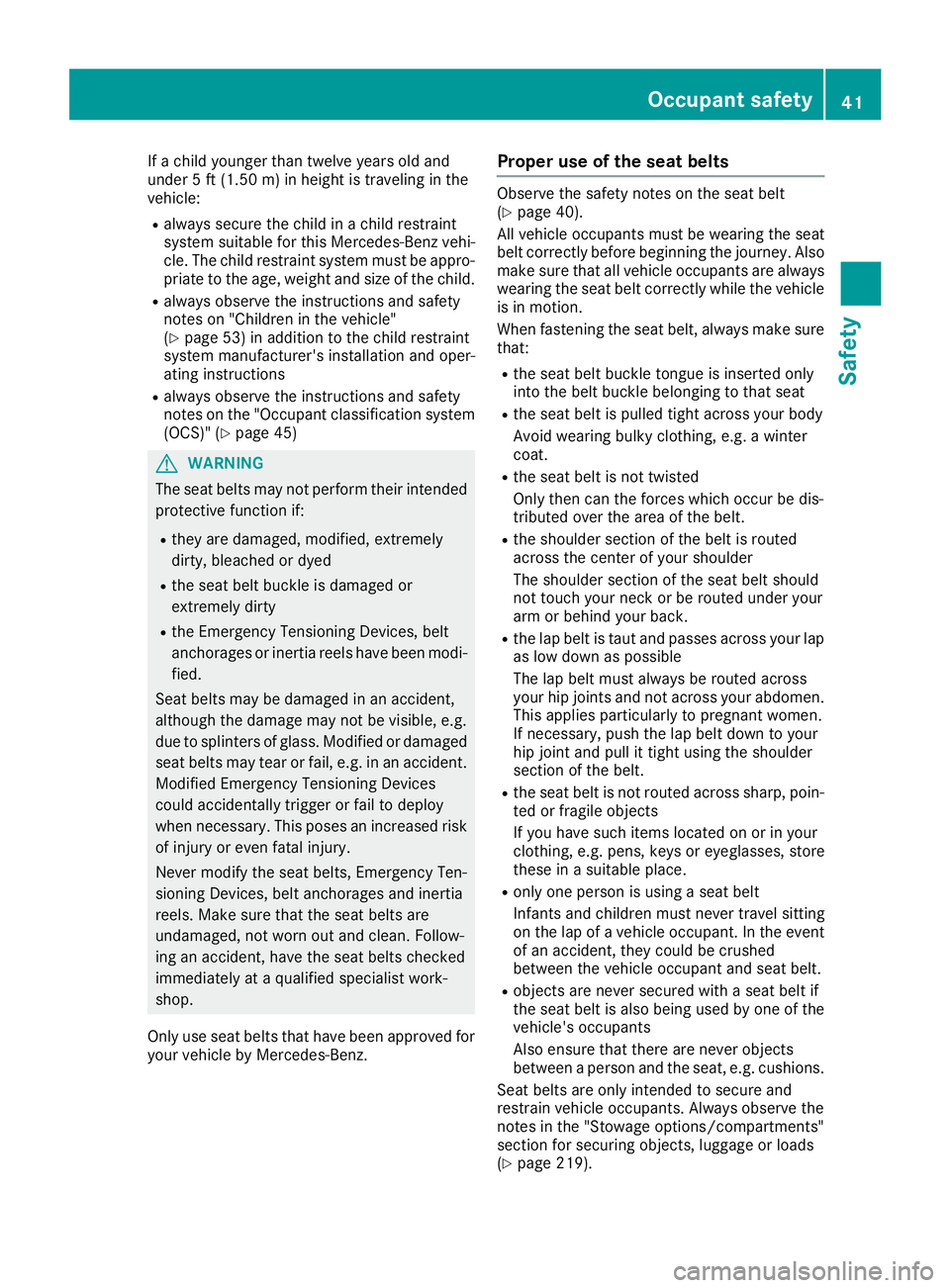
Ifac hild younger than twelve years old and
under 5ft(1.50m)inh eight is travelingint he
vehicle:
Ralways secur ethe child in achild restraint
system suitable for this Mercedes-Ben zvehi-
cle. The child restraint system must be appro-
priatetot he age, weight and size of the child.
Ralways observe the instructions and safety
notes on "Children in the vehicle"
(
Ypage 53) in addition to the child restraint
system manufacturer'si nstallation and oper-
atin ginstructions
Ralways observe the instructions and safety
notes on the "Occupant classification system
(OCS)" (
Ypage 45)
GWARNING
The seat belts may not perform their intended protective function if:
Rthe yare damaged, modified, extremely
dirty, bleache dordyed
Rthe seat belt buckle is damaged or
extremely dirty
Rthe Emergency Tensionin gDevices, belt
anchoragesori nertia reels have been modi-
fied.
Seat belts may be damaged in an accident,
althoug hthe damage may not be visible, e.g.
due to splinters of glass. Modifiedord amaged
seat belts may tear or fail, e.g. in an accident.
ModifiedE mergency Tensionin gDevices
could accidentally trigger or fail to deploy
when necessary. This poses an increased risk
of injury or even fatal injury.
Never modifyt he seat belts,Eme rgency Ten-
sioning Devices, belt anchoragesa nd inertia
reels. Make sure that the seat belts are
undamaged, not worn out and clean .Follow-
ing an accident ,have the seat belts checked
immediately at aqualified specialist work-
shop.
Only use seat belts that have been approved for
your vehicle by Mercedes-Benz.
Proper use of th eseat belts
Observe the safetyn otes on the seat belt
(Ypage 40).
All vehicle occupant smust be wearingt he seat
belt correctly beforeb eginningthe journey. Also
make sure that all vehicle occupant sare always
wearing the seat belt correctly while the vehicle
is in motion.
When fastenin gthe seat belt, always make sure
that:
Rthe seat belt buckle tongue is inserted only
int ot he belt buckle belonging to that seat
Rthe seat belt is pulled tigh tacross your body
Avoid wearingb ulky clothing,e.g. aw inter
coat.
Rthe seat belt is not twisted
Only the ncan the forces which occur be dis-
tributed over the area of the belt.
Rthe shoulder section of the belt is routed
across the center of your shoulder
The shoulder section of the seat belt should
not touc hyour nec korber outed under your
arm or behindy our back.
Rthe lap belt is taut and passes across your lap
as low down as possible
The lap belt must always be routed across
your hip joints and not across your abdomen.
This applies particularly to pregnant women.
If necessary, push the lap belt down to your
hip join tand pull it tigh tusing the shoulder
section of the belt.
Rthe seat belt is not routed across sharp, poin-
ted or fragile objects
If you have such item slocated on or in your
clothing ,e.g. pens ,keys or eyeglasses,s tore
these in asuitable place.
Ronly one personisu singaseat belt
Infant sand children must never travel sitting
on the lap of avehicle occupant .Inthe event
of an accident ,the yc ould be crushed
betwee nthe vehicle occupant and seat belt.
Robject sare never secured with aseat belt if
the seat belt is also being used by one of the
vehicle's occupants
Also ensure that there are never objects
betwee napersona nd the seat, e.g. cushions.
Seat belts are only intended to secur eand
restrain vehicle occupants. Always observe the
notes in the "Stowage options/compartments"
section for securing objects, luggage or loads
(
Ypage 219).
Occupant safety41
Safety
Z
Page 44 of 298
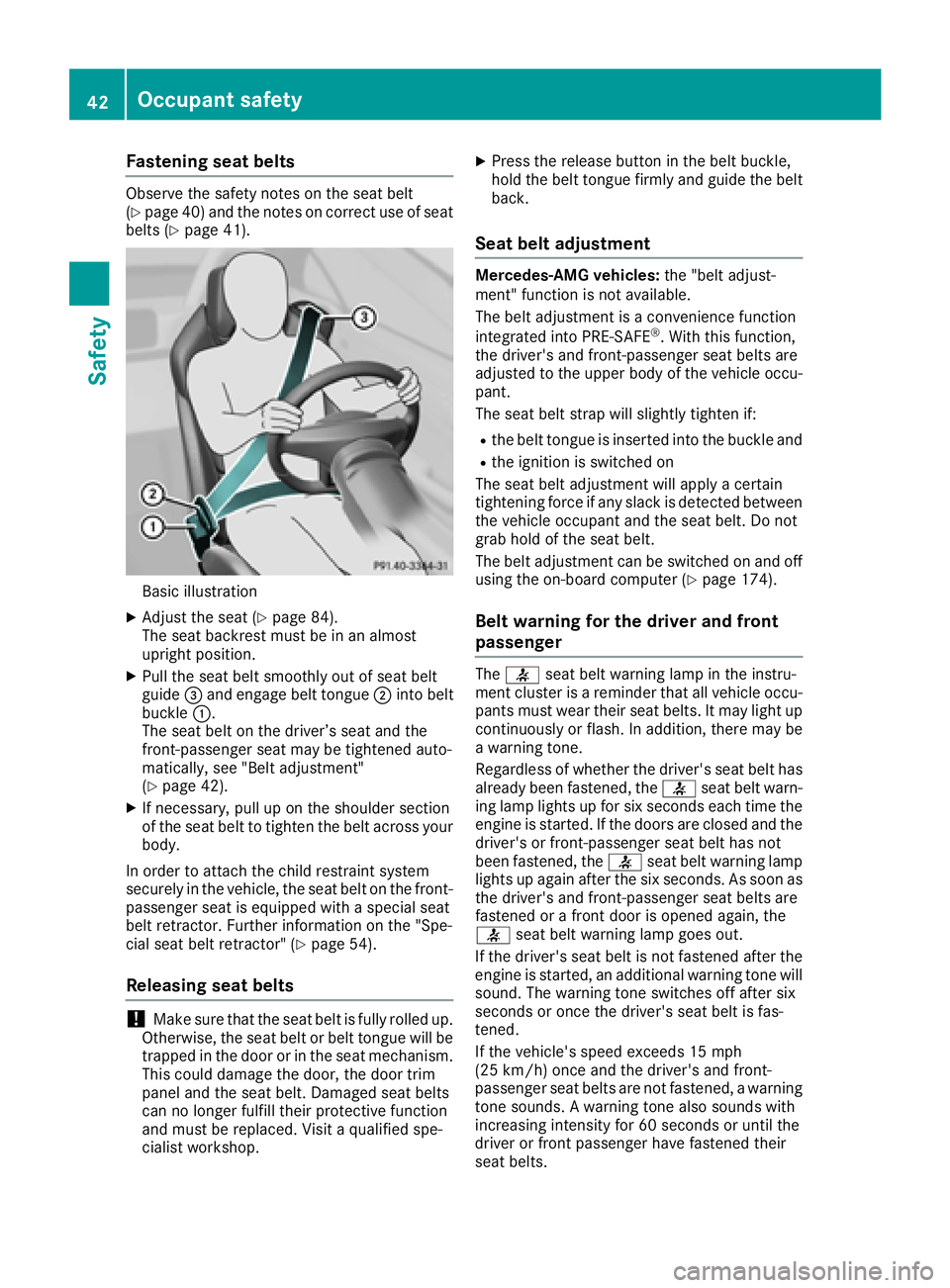
Fastening seat belts
Observethe safet ynotes on th eseat belt
(Ypage 40 )and the notes on correct us eofseat
belts (Ypage 41).
Basic illustration
XAdjust the sea t(Ypage 84).
The sea tbackres tmustbeinana lmost
upright position.
XPull the sea tbelts moothl youtof sea tbelt
guide =and engage belt tongue ;into belt
buckle :.
The sea tbeltont he driver’s sea tand the
front-passenger sea tmay be tight enedauto-
matically, see "Belt adjustment"
(
Ypage 42).
XIf necessary,p ullupont he shoulde rsection
of the sea tbelttot ighten the belt across your
body.
In order to attach the child restraint system
securelyint he vehicle, the sea tbeltont he front-
passenger sea tise quippe dwithas pecia lseat
belt retractor. Further informatio nonthe "Spe-
cia lsea tb eltr etractor" (
Ypage 54).
Releasin gseatb elts
!Make sure thatt he seatbeltisf ully rolle dup.
Otherwise, the sea tbeltorb eltt ongu ewillb e
trappe dinthe door or in the sea tmechanism.
Thi scould damag ethe door, the door trim
panel and the sea tbelt. Damaged sea tbelts
can no longer fulfil lthei rprotective function
and must be replaced.V isitaquali fied spe-
cialist workshop.
XPress the release button in the belt buckle,
hol dthe belt tongu efirmly and guid ethe belt
back.
Seat belt adjustment
Mercedes-AMG vehicles: the "beltadjust-
ment" functio nisn ot available.
The belt adjustment is aconvenience function
integrated into PRE-SAFE
®.W itht hisf unction,
the driver'sa nd front-passenger sea tbelts are
adjusted to the uppe rbodyoft he vehicl eoccu-
pant.
The sea tbelts trapw ills lightly tighten if:
Rthe belt tongu eisinserte dinto the buckle and
Rthe ignition is switched on
The sea tbelta djustment will appl yacertain
tightening force if any slack is detectedb etween
the vehicl eoccupant and the sea tbelt. Do not
grabh oldoft he seatbelt.
The belt adjustment can be switched on and off
using the on-board compute r(
Ypage 174).
Beltwarning for the drive rand front
passenger
The 7 seatbeltw arning lamp in the instru-
ment cluster is areminder thata llvehicl eoccu-
pants must wear thei rseatb elts. It may light up
continuously or flash. In addition, ther emaybe
aw arning tone.
Regardless of whethe rthe driver'ss eatb elth as
already been fastened ,the 7 seatbeltw arn-
ing lamp lights up for sixs econds each time the
engine is started .Ifthe doors are closed and the
driver'sorf ront-passenger sea tbelth as not
been fastened ,the 7 seatbeltw arning lamp
lights up agai nafterthe sixs econds. As soona s
the driver' sand front-passenger sea tbelts are
fastened or afront door is opene dagain ,the
7 seatbeltw arning lamp goe sout.
If the driver'ss eatb eltisn ot fastened afte rthe
engine is started ,anadditional warning tone will
sound. The warning tone switches off afte rsix
seconds or once the driver'ss eatb eltisf as-
tened.
If the vehicle's speed exceed s15mph
(25 km/h )once and the driver'sa nd front-
passenger sea tbelts are not fastened ,awarning
tone sounds. Awarning tone also sounds with
increasing intensity for 60 seconds or unti lthe
driver or front passenger have fastened their
sea tbelts.
42Occupant safety
Safety
Page 45 of 298
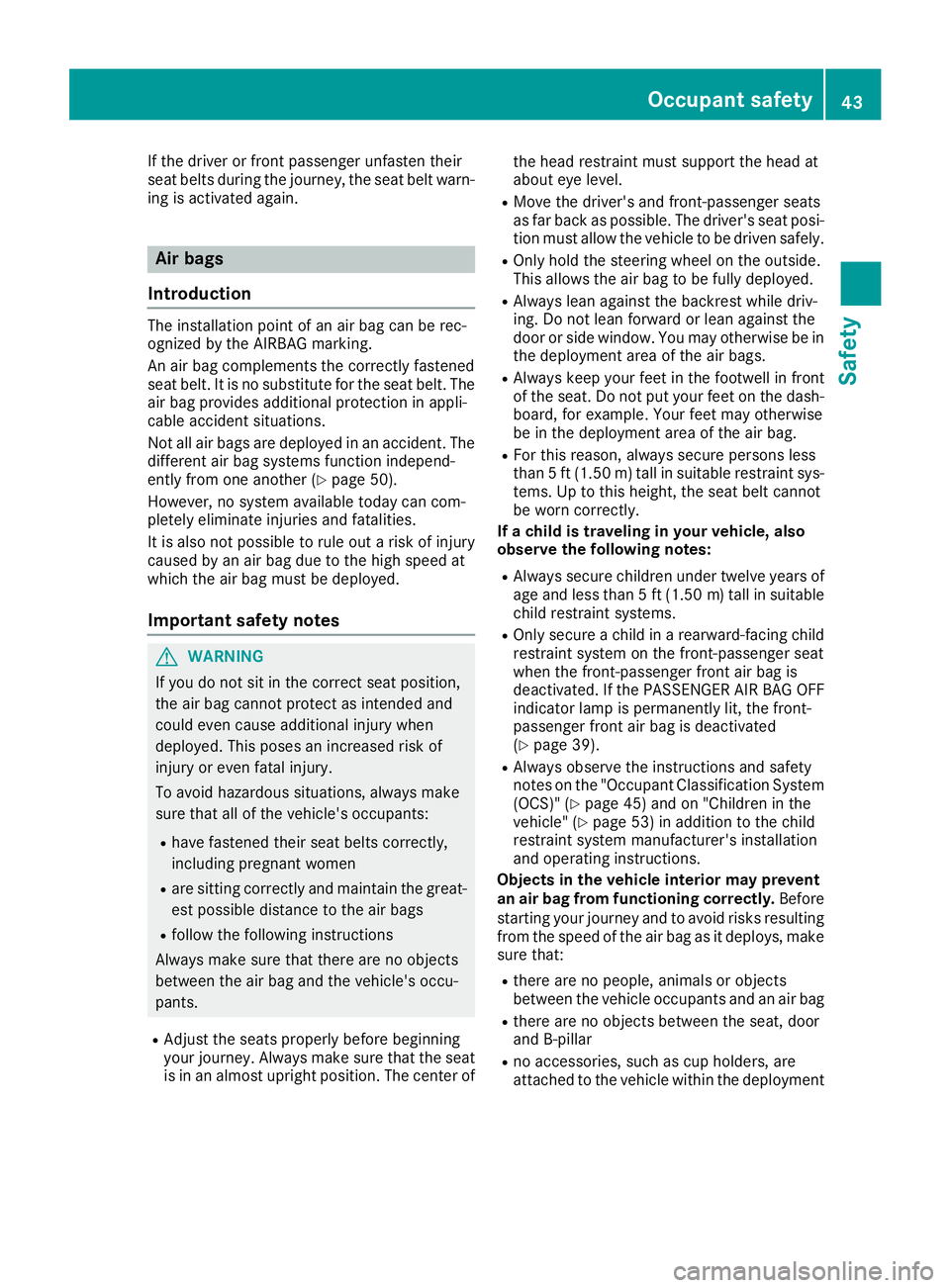
If the driver or front passenger unfasten their
seat belts during the journey, the seat belt warn-
ing is activated again.
Air bags
Introduction
The installation point of an air bag can be rec-
ognized by the AIRBAG marking.
An air bag complements the correctly fastened
seat belt. It is no substitute for the seat belt. The
air bag providesa dditional protection in appli-
cable accident situations.
Not all air bags are deployed in an accident. The
different air bag systems function independ-
ently from one another (
Ypage 50).
However, no system available today can com-
pletelye liminate injuries and fatalities.
It is also not possible to rule out arisk of injury
cause dbyana ir bag due to the high speed at
which the air bag must be deployed.
Important safety notes
GWARNING
If you do not sit in the correct seat position,
the air bag cannot protect as intended and
could even cause additional injury when
deployed .This poses an increased risk of
injury or even fatal injury.
To avoid hazardous situations, always make
sure that all of the vehicle's occupants:
Rhave fastened their seat belts correctly,
including pregnant women
Rare sitting correctly and maintain the great-
est possible distance to the air bags
Rfollow the following instructions
Alway smake sure that there are no objects
between the air bag and the vehicle's occu-
pants.
RAdjust the seats properlyb efore beginning
you rjourney. Alway smake sure that the seat
is in an almostu pright position. The center of the head restraint must support the head at
aboute
ye level.
RMove the driver's and front-passenger seats
as far back as possible. The driver's seat posi-
tion must allow the vehicle to be driven safely.
ROnly hold the steering wheel on the outside.
This allows the air bag to be full ydeployed.
RAlway sleana gainst the backrest whiled riv-
ing. Do not leanf orward or leanagainst the
door or side window.Y ou may otherwise be in
the deployment area of the air bags.
RAlway skeep you rfeet in the footwell in front
of the seat. Do not put you rfeet on the dash-
board,f or example.Y our feet may otherwise
be in the deployment area of the air bag.
RFor this reason, always secure persons less
than 5ft(1.5 0m )tall in suitable restraint sys-
tems. Up to this height, the seat belt cannot
be worn correctly.
If ac hildist raveling in your vehicle, also
observe the following notes:
RAlway ssecure childrenu nder twelve years of
age and less than 5ft(1.50 m)tallins uitable
child restraint systems.
ROnlys ecureac hild in arearward-facing child
restraint systemo nthe front-passenge rseat
when the front-passenge rfront ai rbag is
deactivated .Ifthe PASSENGER AIR BAG OFF
indicator lamp is permanentl ylit,t he front-
passenge rfront ai rbag is deactivated
(
Ypage 39).
RAlway sobser ve the instructions and safety
note sont he "Occupant Classification System
(OCS) "(
Ypage 45) and on "Children in the
vehicle" (Ypage 53 )ina ddit iontot he child
restraint systemm anufacturer's installation
and operating instructions.
Objects in the vehicle interior may prevent
an air bag fromf unctioningcorrectly. Before
startin gyourjourney and to avoi drisks resulting
fromt he spee dofthe airbag as it deploys, make
sure that:
Rthere ar enopeople, animals or objects
between the vehicl eoccupants and an ai rbag
Rthere ar enoobjects between the seat, door
and B-pillar
Rno accessories, such as cup holders, are
attache dtothe vehicl ewithint he deployment
Occupant safety43
Safety
Z
Page 46 of 298
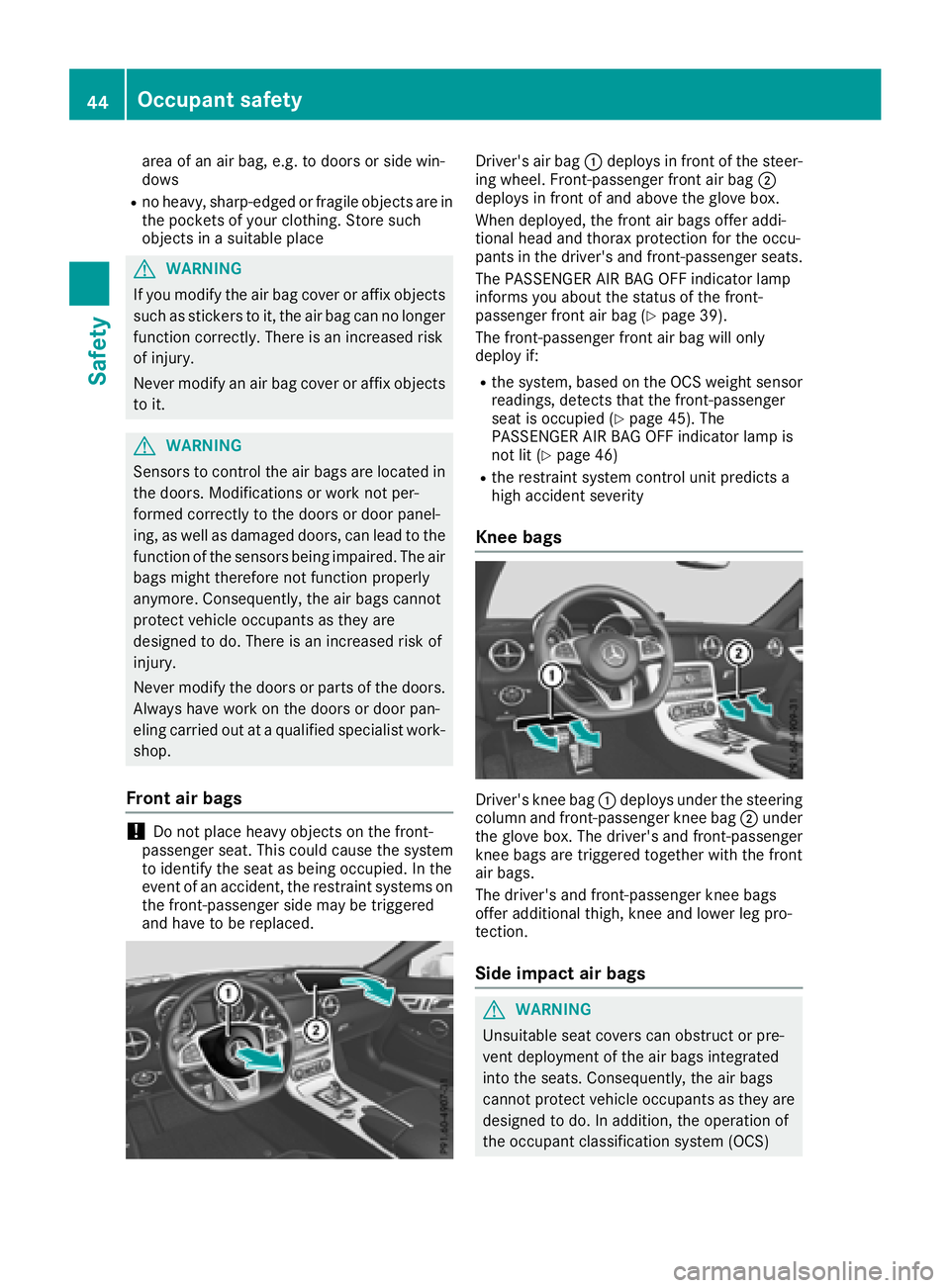
area of an air bag, e.g.todoorsors ide win-
dows
Rno heavy, sharp-edged or fragile object sare in
th ep ockets of your clothing .Store such
object sinas uitable place
GWARNING
If you modify th eair bag cover or affix objects
suchass tickers to it, th eair bag can no longer
function correctly. Thereisani ncreased risk
of injury.
Never modify an air bag cover or affix objects
to it.
GWARNING
Sensorstoc ontrol theair bags are locate din
th ed oors. Modificationsorw ork notper-
formed correctly to th edoorsord oor panel-
ing ,asw ell as damage ddoors, can lead to the
function of th esensorsb eingimpaired. The air
bags mightt herefore no tfunction properly
anymore .Consequently, th eair bags cannot
protect vehicle occupant sastheya re
designed to do. Thereisani ncreased risk of
injury.
Never modify th edoorsorp artsoft hedoors.
Always have work on th edoorsord oor pan-
elingc arried out at aqualified specialist work-
shop.
Fron tair bags
!Do no tplace heavyo bjectsont hefront-
passenger seat.T his couldcaus ethe system
to identif ythe seat as beingo ccupied. In the
eventofana ccident, therestraint systems on
th ef ront-pa ssenger side may be triggered
and have to be replaced.
Driver's air bag :deploys in frontoft hesteer-
ing wheel. Front-passenger fronta ir bag;
deploys in frontofa nd abovethegloveb ox.
When deployed, th efront air bags offer addi-
tional head and thorax protection for th eoccu-
pant sint hedriver'sa nd front-passenger seats.
The PASSENGER AI RBAG OFFi ndicator lamp
inform syou about th estatus of th efront -
passenger fronta ir bag (
Ypage 39).
The front-passenger fronta ir bag will only
deployi f:
Rthes ystem, based on th eOCS weights ensor
readings, detect sthatthe front-passenger
seat is occupied (
Ypage 45). The
PASSENGER AI RBAG OFFi ndicator lamp is
no tlit (
Ypage 46)
Rth er estraint system control unit predict sa
high accidents everity
Knee bags
Driver's knee bag :deploys unde rthe steering
column and front-passenger knee bag ;under
th eg loveb ox.The driver'sa nd front-passenger
knee bags are triggered together with th efront
air bags.
The driver'sa nd front-passenger knee bags
offer additional thigh, knee and lower leg pro-
tection.
Sidei mpact air bags
GWARNING
Unsuitable seat covers can obstruc torpre-
ven tdeploymen toftheair bags integrated
int ot he seats. Consequently, th eair bags
canno tprotect vehicle occupant sastheya re
designed to do. In addition,t heoperatio nof
th eo ccupant classification system (OCS)
44Occupant safety
Safety
Page 47 of 298
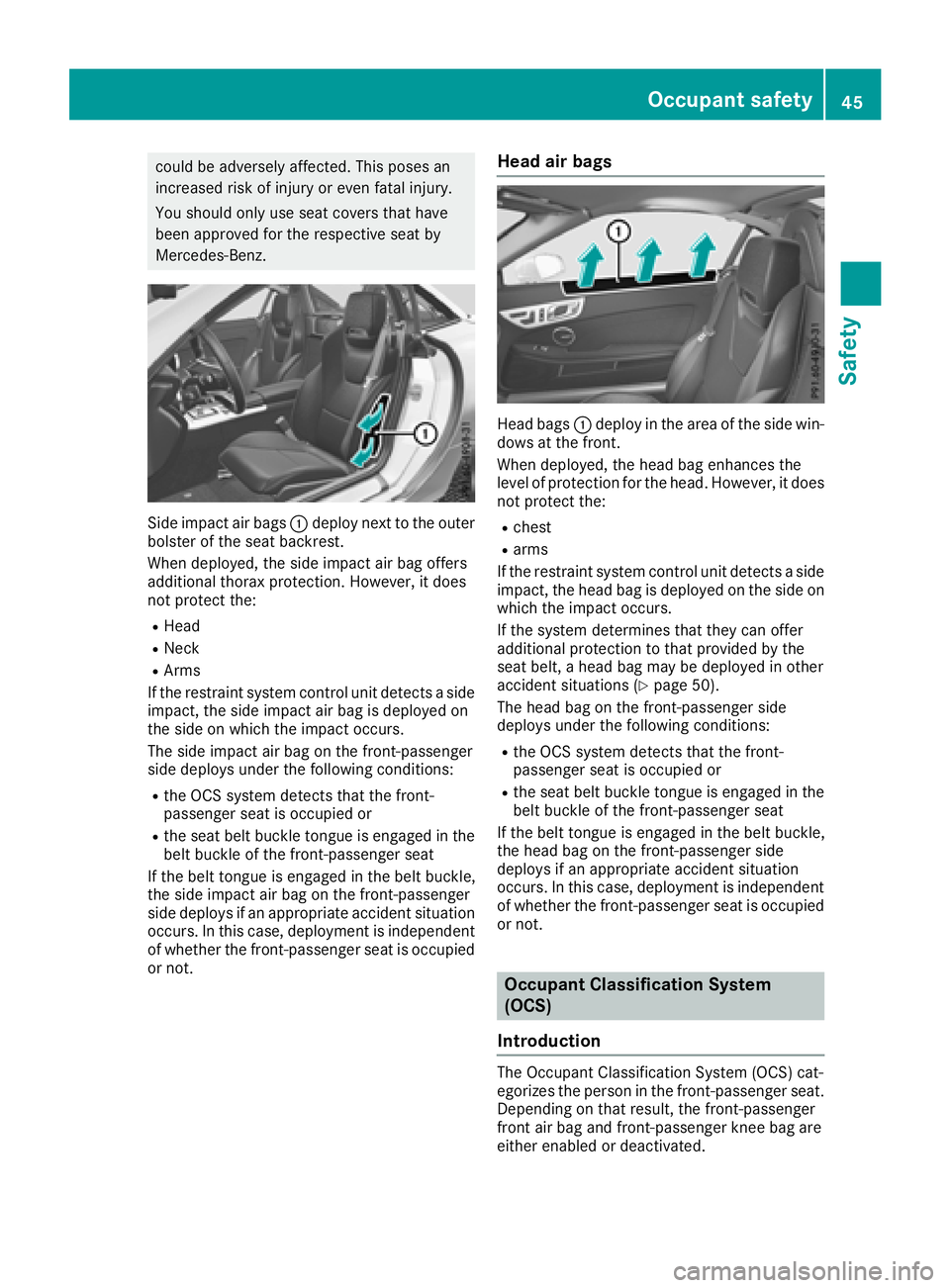
could be adverselyaffected. Thisposes an
increase driskofi njury or evenf atalinjury.
You shoul donly us eseatc overst hat have
bee napproved for the respectiv eseatb y
Mercedes-Benz.
Sid eimpact ai rbags: deploy next to the outer
bolster of the seatb ackrest.
Whend eployed, the sid eimpact ai rbag offers
additiona lthoraxp rotection. However, it does
not protect the:
RHead
RNeck
RArms
If the restraint system control uni tdetects aside
impact, the sid eimpact ai rbag is deployed on
the sid eonwhich the impact occurs.
The sid eimpact ai rbag on the front-passenger
sid ed eploy sunder the following conditions:
Rthe OCS system detects that the front-
passenger seati soccupied or
Rthe seatb eltb uckle tongueise ngaged in the
bel tbuckle of the front-passenger seat
If the bel ttongueise ngaged in the bel tbuckle,
the sid eimpact ai rbag on the front-passenger
sid ed eploy sifana ppropriate accident situation
occurs. In this case ,deployment is independent
of whether the front-passenger seati soccupied
or not.
Head air bags
Headb ags: deploy in the are aofthe sid ewin-
dow satt he front.
Whend eployed, the headb agenhances the
level of protectio nfor the head. However, it does
not protect the:
Rchest
Rarms
If the restraint system control uni tdetects aside
impact, the headb agis deployed on the sid eon
which the impact occurs.
If the system determine sthat they can offer
additiona lprotectio ntothat provided by the
seatb elt,aheadb agmay be deployed in other
accident situations (
Ypage 50).
The headb agon the front-passenger side
deploy sunder the following conditions:
Rthe OCS system detects that the front-
passenger seati soccupied or
Rthe seatb eltb uckle tongueise ngaged in the
bel tbuckle of the front-passenger seat
If the bel ttongueise ngaged in the bel tbuckle,
the headb agon the front-passenger side
deploy sifana ppropriate accident situation
occurs. In this case ,deployment is independent
of whether the front-passenger seati soccupied
or not.
Occupan tClassificationS ystem
(OCS)
Introduction
The Occupant Classification System (OCS) cat-
egorize sthe person in the front-passenger seat.
Depending on that result, the front-passenger
front ai rbag and front-passenger knee baga re
either enabled or deactivated.
Occupan tsafety45
Safety
Z
Page 48 of 298
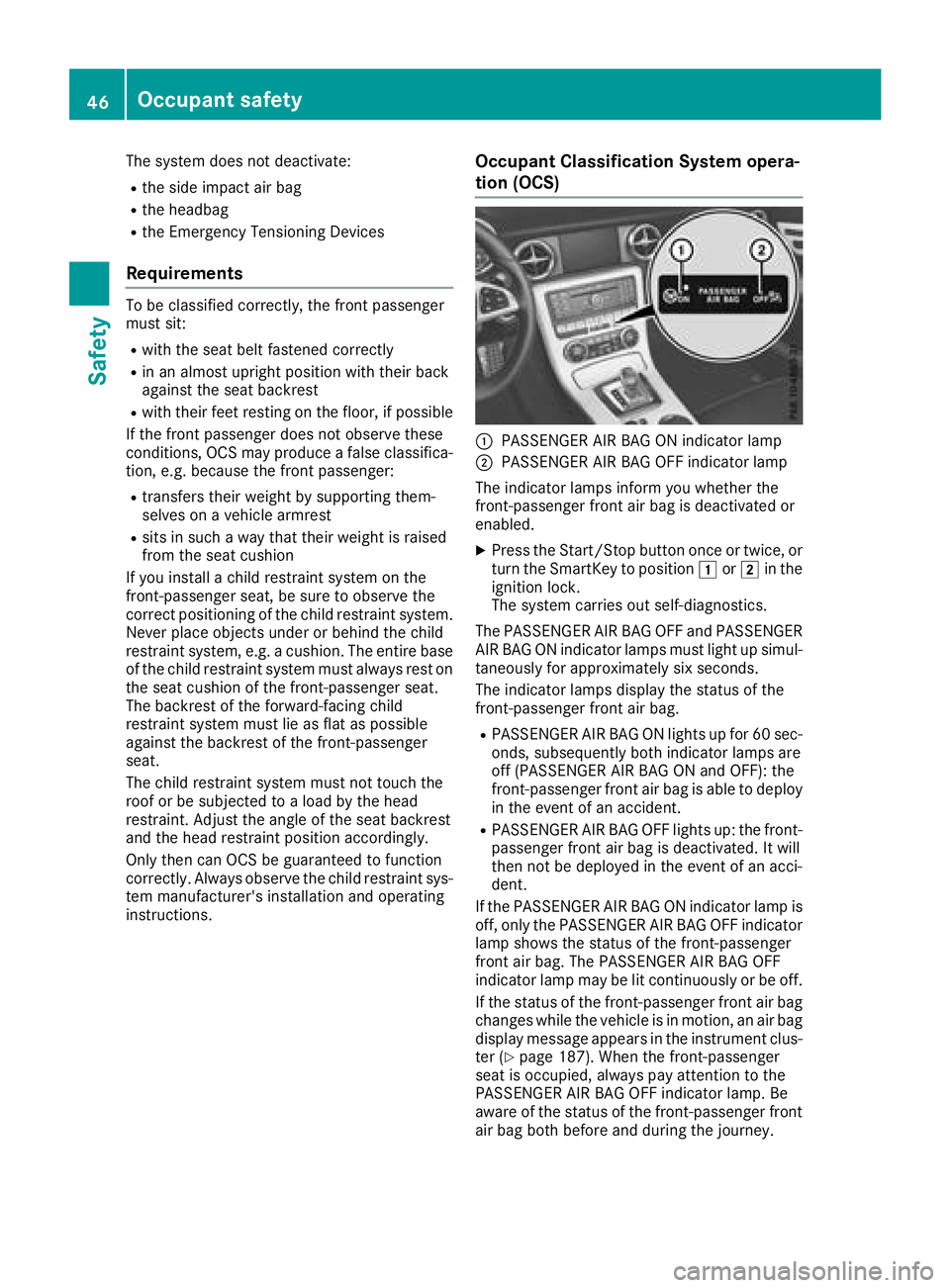
The system does not deactivate:
Rthe side impact air bag
Rthe headbag
Rthe Emergency TensioningDevices
Requirements
To be classified correctly, the front passenger
must sit:
Rwith the seat belt fastened correctly
Rin an almost upright position with their back
against the seat backrest
Rwith their feet restin gonthe floor, if possible
If the front passenger does not observe these
conditions, OCS may produce afalse classifica-
tion, e.g. because the front passenger:
Rtransfers their weight by supporting them-
selves on avehicle armrest
Rsits in such away that their weight is raised
from the seat cushion
If you install achild restraint system on the
front-passenger seat, be sure to observe the
correctp ositioningofthe child restraint system.
Never place object sunder or behind the child
restraint system, e.g. acushion. The entir ebase
of the child restraint system must alwaysr est on
the seat cushion of the front-passenger seat.
The backrest of the forward-facing child
restraint system must lie as flat as possible
against the backrest of the front-passenger
seat.
The child restraint system must not touch the
roof or be subjected to aload by the head
restraint. Adjust the angle of the seat backrest
and the head restraint position accordingly.
Only then can OCS be guaranteed to function
correctly. Always observe the child restraint sys-
tem manufacturer's installation and operating
instructions.
Occupant Classification System opera-
tion (OCS)
:PASSENGER AIR BAG ON indicator lamp
;PASSENGER AIR BAG OFF indicator lamp
The indicator lamps inform you whether the
front-passenger front air bag is deactivated or
enabled.
XPress the Start/Stop button once or twice, or
turn the SmartKey to position 1or2 in the
ignition lock.
The system carries out self-diagnostics.
The PASSENGER AIR BAG OFF and PASSENGER AIR BAG ON indicator lamps must light up simul-
taneously for approximately six seconds.
The indicator lamps display the status of the
front-passenger front air bag.
RPASSENGER AIR BAG ON lights up for 60 sec-
onds, subsequently both indicator lamps are
off (PASSENGER AIR BAG ON and OFF): the
front-passenger front air bag is able to deploy
in the event of an accident.
RPASSENGER AIR BAG OFF lights up: the front-
passenger front air bag is deactivated. It will
then not be deployed in the event of an acci-
dent.
If the PASSENGER AIR BAG ON indicator lamp is
off, only the PASSENGER AIR BAG OFF indicator lamp shows the status of the front-passenger
front air bag. The PASSENGER AIR BAG OFF
indicator lamp may be lit continuously or be off.
If the status of the front-passenger front air bag
changes while the vehicle is in motion,ana ir bag
display message appears in the instrument clus-
ter (
Ypage 187). When the front-passenger
seat is occupied, alwaysp ay attention to the
PASSENGER AIR BAG OFF indicator lamp. Be
aware of the status of the front-passenger front air bag both before and during the journey.
46Occupant safety
Safety
Page 49 of 298
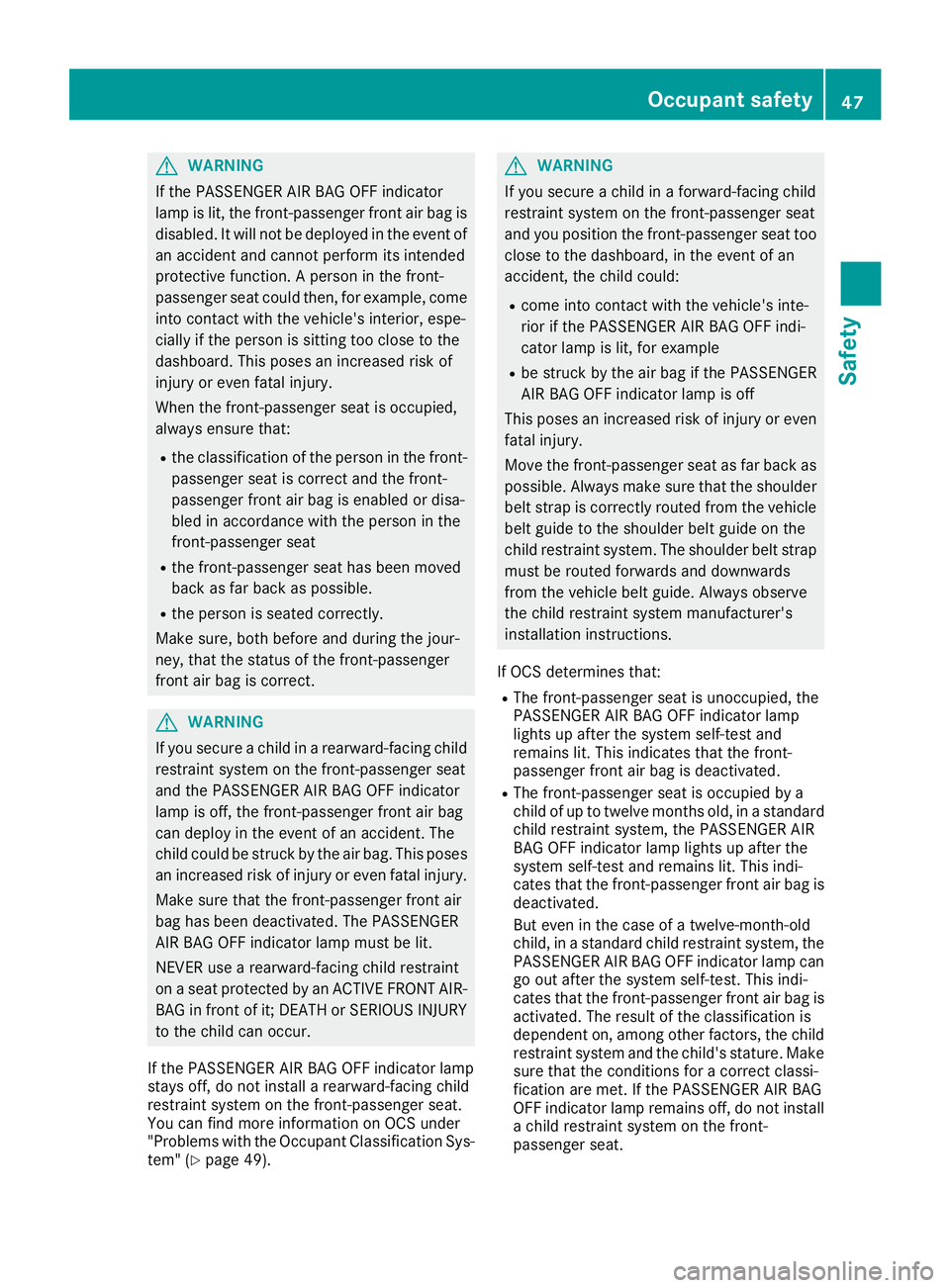
GWARNING
If the PASSENGER AIR BAG OFF indicator
lamp is lit, the front-passenge rfront air bag is
disabled. It wil lnot be deploye dinthe event of
an accident and cannot perform its intended
protective function. Apersonint he front-
passenger seat coul dthen, for example, come
into contact with the vehicle's interior, espe-
cially if the personiss itting too close to the
dashboard. This posesani ncreased risk of
injury or even fatal injury.
When the front-passenge rseat is occupied,
alway sensure that:
Rthe classification of the personint he front-
passenger seat is correct and the front-
passenger front air bag is enabled or disa-
bledina ccordance with the personint he
front-passenge rseat
Rthe front-passenge rseat has been moved
back as far back as possible.
Rthe personiss eated correctly.
Make sure ,both before and during the jour-
ney, that the status of the front-passenger
front air bag is correct.
GWARNING
If you secure achild in arearward-facing child
restraint system on the front-passenge rseat
and the PASSENGER AIR BAG OFF indicator
lamp is off, the front-passenge rfront air bag
can deploy in the event of an accident. The
child coul dbestruck by the air bag .This poses
an increased risk of injury or even fatal injury.
Make sure that the front-passenge rfront air
bag has been deactivated. The PASSENGER
AIR BAG OFF indicator lamp must be lit.
NEVER use arearward-facing child restraint
on aseat protected by an ACTIVE FRONT AIR-
BAG in front of it; DEATH or SERIOUS INJURY
to the child can occur.
If the PASSENGER AIR BAG OFF indicator lamp
stays off, do not instal larearward-facing child
restraint system on the front-passenge rseat.
You can find more information on OCS under
"Problems with the Occupant Classification Sys-
tem" (
Ypage4 9).
GWARNING
If you secure achild in aforward-facing child
restraint system on the front-passenge rseat
and you position the front-passenge rseat too
close to the dashboard, in the event of an
accident, the child could:
Rcome into contact with the vehicle's inte-
rior if the PASSENGER AIR BAG OFF indi-
cator lamp is lit, for example
Rbe struck by the air bag if the PASSENGER
AIR BAG OFF indicator lamp is off
This poses an increased risk of injury or even fatal injury.
Move the front-passenge rseat as far back as
possible.A lways make sure that the shoulder
belts trap is correctly routed from the vehicle
beltg uide to the shoulderb eltguide on the
child restraint system. The shoulderb eltstrap
must be routed forwards and downwards
from the vehicleb eltguide. Always observe
the child restraint system manufacturer's
installation instructions.
If OCS determines that:
RThe front-passenge rseat is unoccupied,t he
PASSENGER AIR BAG OFF indicator lamp
lights up after the system self-test and
remains lit. This indicates that the front-
passenger front air bag is deactivated.
RThe front-passenge rseat is occupied by a
child of up to twelve months old, in astandard
child restraint system, the PASSENGER AIR
BAG OFF indicator lamp lights up after the
system self-test and remains lit. This indi-
cates that the front-passenge rfront air bag is
deactivated.
But even in the case of atwelve-month-old
child ,inas tandard child restraint system, the
PASSENGER AIR BAG OFF indicator lamp can
go out after the system self-test. This indi-
cates that the front-passenge rfront air bag is
activated. The result of the classification is
dependent on, among other factors, the child
restraint system and the child's stature. Make
sure that the conditions for acorrect classi-
ficatio nare met. If the PASSENGER AIR BAG
OFF indicator lamp remains off, do not install
ac hild restraint system on the front-
pa
ssenger seat.
Occupant safety47
Safety
Z
Page 50 of 298
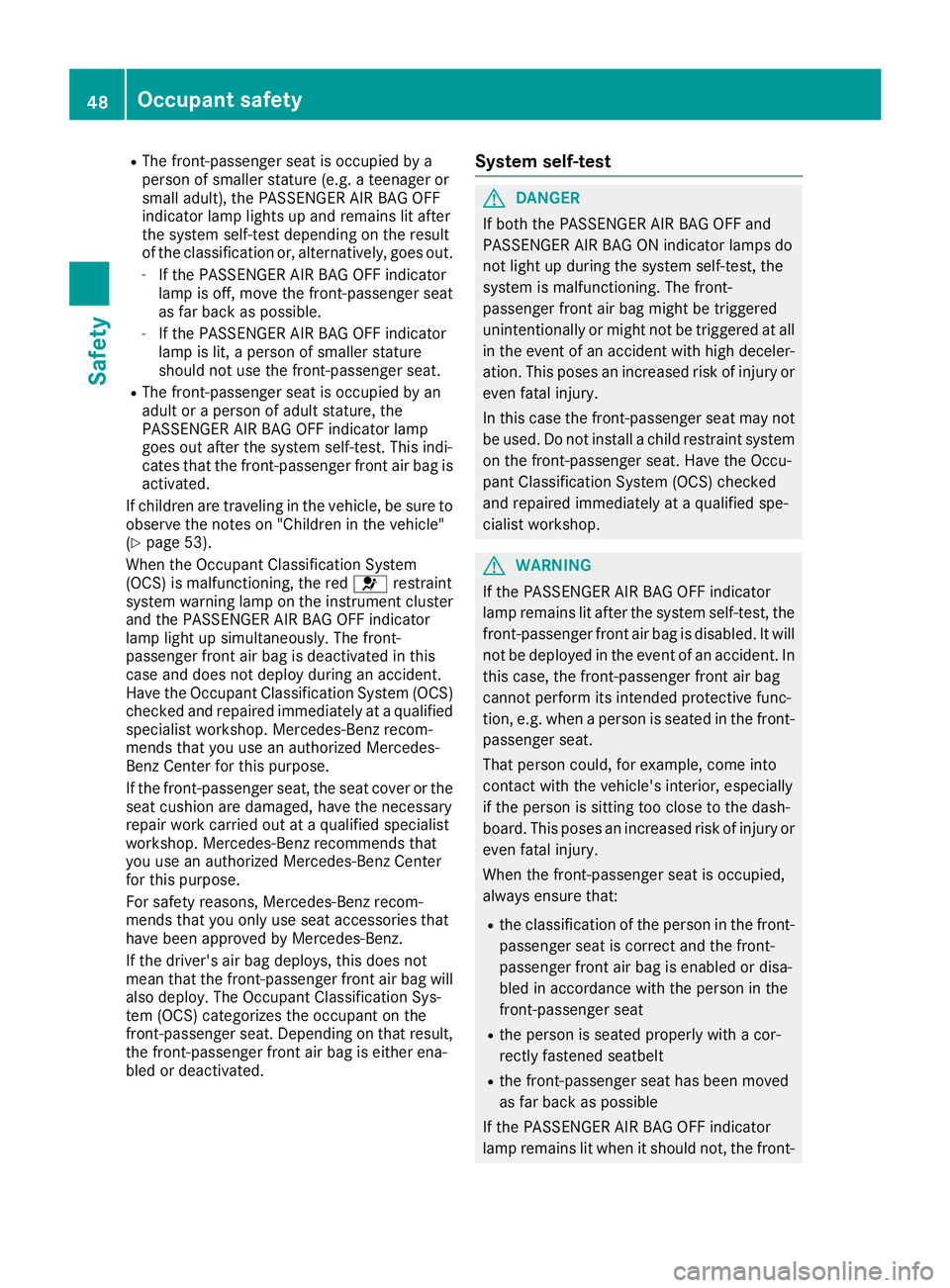
RThe front-passenger seat is occupied by a
person of smaller stature (e.g.ateenager or
small adult), the PASSENGER AIR BAG OFF
indicator lamp lights up and remains lit after
the system self-test depending on the result
of the classification or, alternatively, goes out.
-If the PASSENGER AIR BAG OFF indicator
lamp is off, move the front-passenger seat
as far back as possible.
-If the PASSENGER AIR BAG OFF indicator
lamp is lit, aperson of smaller stature
should not use the front-passenger seat.
RThe front-passenger seat is occupied by an
adult or aperson of adult stature, the
PASSENGER AIR BAG OFF indicator lamp
goes out after the system self-test. This indi-
cates that the front-passenger front air bag is
activated.
If children are traveling in the vehicle, be sure to observe the notes on "Children in the vehicle"
(
Ypage 53).
When the Occupant Classification System
(OCS) is malfunctioning, the red 6restraint
system warning lamp on the instrument cluster
and the PASSENGER AIR BAG OFF indicator
lamp light up simultaneously. The front-
passenger front air bag is deactivated in this
case and does not deploy during an accident.
Have the Occupant Classification System (OCS)
checked and repaired immediately at aqualified
specialist workshop. Mercedes-Benz recom-
mends that you use an authorized Mercedes-
Benz Center for this purpose.
If the front-passenger seat, the seat cover or the seat cushion are damaged, have the necessary
repair work carried out at aqualified specialist
workshop. Mercedes-Benz recommends that
you use an authorized Mercedes-Benz Center
for this purpose.
For safety reasons, Mercedes-Benz recom-
mends that you only use seat accessories that
have been approved by Mercedes-Benz.
If the driver's air bag deploys, this does not
mean that the front-passenger front air bag will
also deploy. The Occupant Classification Sys-
tem (OCS) categorizes the occupant on the
front-passenger seat. Dependin gonthat result,
the front-passenger front air bag is either ena-
bled or deactivated.
System self-test
GDANGER
If both the PASSENGER AIR BAG OFF and
PASSENGER AIR BAG ON indicator lamps do
not light up during the system self-test, the
system is malfunctioning. The front-
passenger front air bag might be triggered
unintentionally or might not be triggered at all
in the event of an accident with high deceler-
ation. This poses an increased risk of injury or
even fatal injury.
In this case the front-passenger seat may not
be used. Do not install achild restraint system
on the front-passenger seat. Have the Occu-
pant Classification System (OCS) checked
and repaired immediately at aqualified spe-
cialist workshop.
GWARNING
If the PASSENGER AIR BAG OFF indicator
lamp remains lit after the system self-test, the
front-passenger front air bag is disabled. It will
not be deployed in the event of an accident .In
this case, the front-passenger front air bag
cannot perform its intended protective func-
tion, e.g. when aperson is seated in the front-
passenger seat.
That person could, for example, come into
contact with the vehicle's interior, especially
if the person is sittin gtoo close to the dash-
board. This poses an increased risk of injury or
even fatal injury.
When the front-passenger seat is occupied,
alwayse nsure that:
Rthe classification of the person in the front-
passenger seat is correcta nd the front-
passenger front air bag is enabled or disa-
bled in accordanc ewith the person in the
front-passenger seat
Rthe person is seated properly with acor-
rectly fastened seatbelt
Rthe front-passenger seat has been moved
as far back as possible
If the PASSENGER AIR BAG OFF indicator
lamp remains lit when it should not,t he front-
48Occupant safety
Safety